The Fujian Tulou (Nanjing) Scenic Area is located in Shuyang Town and Meilin Town, Nanjing County, Zhangzhou City, Fujian Province. It is a "World Cultural Heritage", "National 5A-level Tourist Scenic Area", "National Water Conservancy Scenic Area" and "National Civilized Unit". The scenic area consists of three major parts: Tianluokeng Area, Yunshuiyao Area and Hekeng Tulou Folk Culture Village Area, covering an area of about 3.03 square kilometers. Characterized by time-honored and uniquely styled tulou buildings, these structures mainly use raw earth as the building material, combined with wood and stone structures, showcasing exquisite craftsmanship. There are more than 3,000 strictly confirmed Fujian tulou buildings existing today. Following the concept of "harmony between man and nature", the tulou buildings integrate with natural landscapes and mountains, being treasures of world residential architecture and forming a livable environment with a harmonious unity of man and nature.
Historical Culture
Fujian tulou originated in the Song and Yuan dynasties and matured in the late Ming, Qing and Republic of China periods. Nanjing has long been known as the "Kingdom of Tulou", with a long history of tulou construction. From the earliest Chaoshuilou (1549—1553) to the latest Yongqinglou (1967—1972), the construction spans 423 years, reflecting the historical evolution of tulou formation and development in different eras.
The construction of tulou is closely related to the social environment and clan culture of the time. They were homes built by Hakka ancestors for their descendants after migration, carrying profound clan emotions and cultural inheritance. For example, the Tianluokeng Tulou Cluster is planned and laid out in accordance with the "Five Halls of the Mingtang" in the "Kaogongji Tu" (Kaogongji Illustrations), and built in the order of the mutual generation of the five elements (metal, wood, water, fire, earth). The couplets on pillars and carved beams and painted rafters in the buildings interpret the ideology of "filial piety and loyalty as the foundation, and farming and reading to pass down the family", embodying the Hakka people's emphasis on and inheritance of traditional culture.
Major Attractions
Tianluokeng Tulou Cluster
Located in Shangban Village, Shuyang Town, Nanjing County, on the slope of Hudong Mountain at an altitude of 787.8 meters, its construction began in the late Yuan and early Ming dynasties and was completed in the 1960s, spanning more than 600 years. Composed of the square Buyunlou, the circular Zhenchanglou, Ruiyunlou, Hechanglou, and the elliptical Wenchanglou, it is commonly known as "Four Dishes and One Soup". It is the most beautiful physical combination and iconic building among Fujian tulou, being a Major National Historical and Cultural Site, one of the first batch of China's Famous Historical and Cultural Villages, one of the first batch of China's Landscape Villages, and was inscribed on the World Cultural Heritage List in 2008.
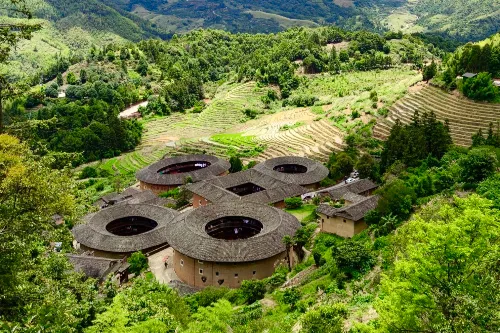
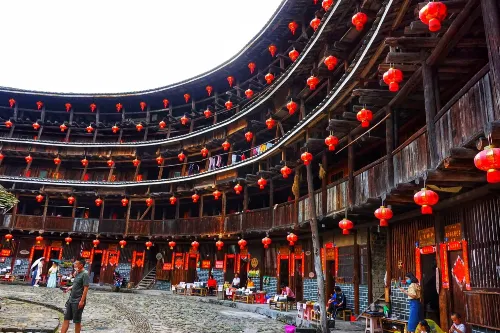
Yuchanglou
Located in Shuyang Town, Nanjing County, built in 1308, it is the oldest existing tulou in Fujian. Jointly funded and built by the clans of five surnames: Liu, Luo, Zhang, Tang and Fan, it has five floors with a height of 18.2 meters and 270 rooms. The entire building has five staircases, divided into five trigrams, and there are 22 wells in the kitchens on the ground floor, making it the tulou with the most wells in Fujian. Its most prominent feature is that the pillars are tilted east and west, with a maximum inclination of 15 degrees, but it has remained stable after 700 years of erosion and numerous earthquakes, becoming a living specimen of ancient residential architecture.
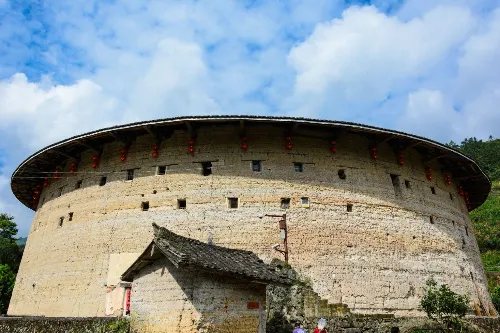
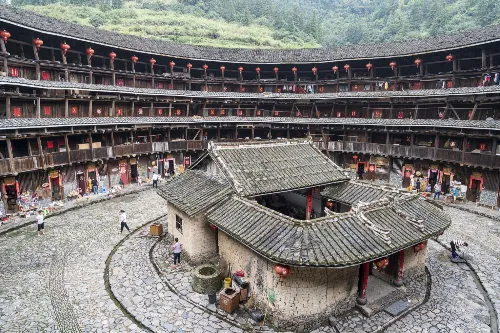
Taxia Village
A National 5A-level Tourist Scenic Area, one of the first batch of China's Best Landscape Villages, and a Provincial-level Famous Historical and Cultural Village, it is known as the "Water Town in the Mountains, Zhouzhuang of Southern Fujian". In the village, streams meander, bamboo shadows dance, and cooking smoke curls up. Apron buildings, stilted buildings, Deyuantang, stone dragon flagpoles and other structures are dotted among them. The Zhang Clan Ancestral Hall Deyuantang in the village is a Major National Historical and Cultural Site, with 24 stone dragon flagpoles standing in front of the hall.
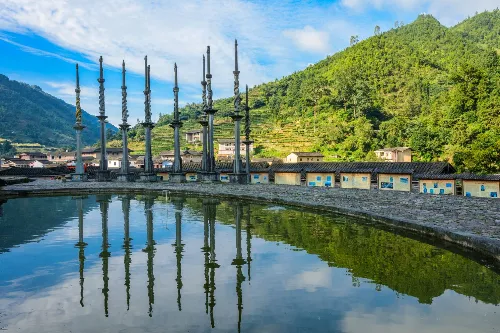
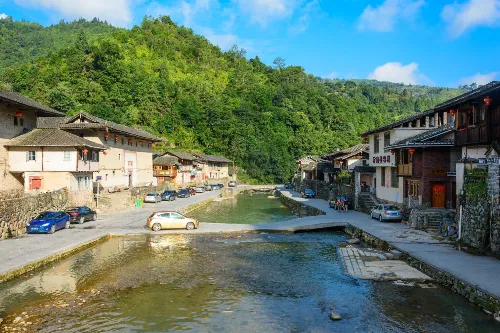
Yunshuiyao Ancient Town
Originally named Changjiao Guanyang Village, with a history of more than 600 years, the ancient town has an ancient plank road paved with pebbles stretching for more than 10 kilometers. It is home to the World Cultural Heritage Heguilou and Huaiyuanlou, as well as the tallest, largest and most concentrated group of thousand-year-old banyan trees in Fujian Province, a century-old street, and a thousand-year-old road. There are 53 well-preserved tulou buildings in the ancient town, built since the mid-Yuan Dynasty, including square, circular, stilted, bamboo pole, and mansion-style tulou, each with a unique landscape.
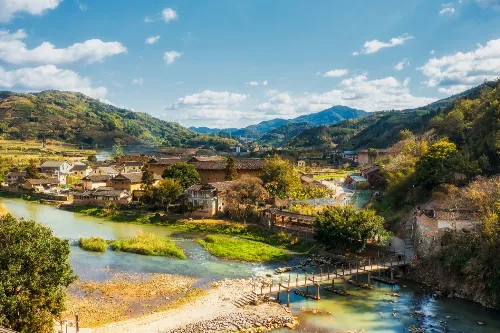
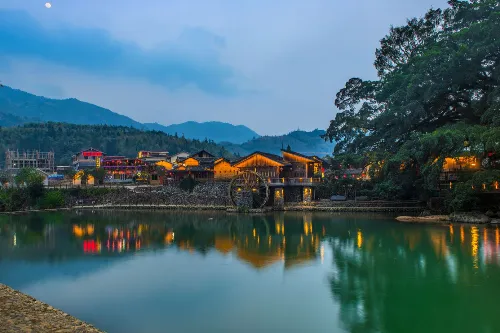
Heguilou
Located in Pushan Village, Meilin Town, Nanjing County, built in the 10th year of the Yongzheng reign of the Qing Dynasty (1732), it is a corridor-style civil structure with 5 floors and a height of 21.5 meters, and the height-thickness ratio of the wall reaches 13:1. Using the suspension principle, with pine wood as pile foundations and raft foundations, it is the tallest square tulou built on a 3,000-square-meter swamp, like a "Noah's Ark" on land.
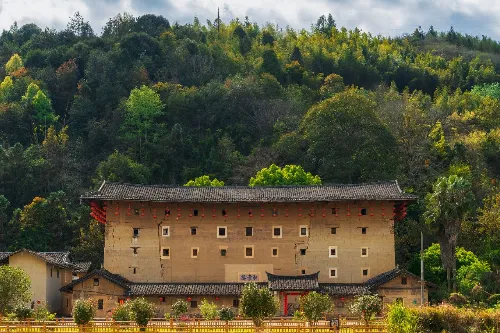
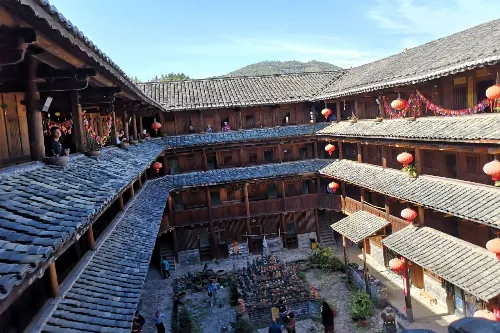
Huaiyuanlou
Located in Kanxia Village, Meilin Town, Nanjing County, built in the late Qing Dynasty (1905-1909), it is the double-ring circular tulou with the most exquisite architectural craftsmanship and the best preservation among Fujian tulou applying for the "World Cultural Heritage". A drum-shaped tulou built using the mature "inclined wall construction" technology, it is the crystallization of the accumulation and improvement of Central Plains rammed earth technology over thousands of years, representing the highest achievement of rammed earth civilization. The couplets on pillars and carved beams and painted rafters in the building interpret the ideology of "filial piety and loyalty as the foundation, and farming and reading to pass down the family".
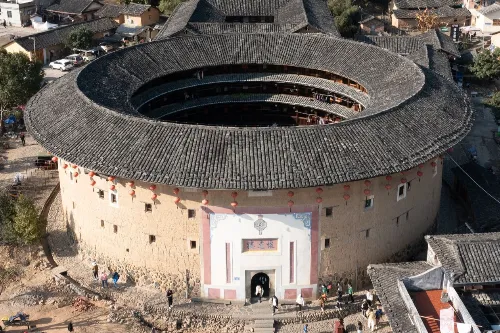

Hekeng Tulou Cluster
It is home to the densest cluster of tulou in Fujian. Seven square tulou built in the Ming and Qing dynasties and seven circular tulou built in modern times form a spectacular astronomical phenomenon of two groups of "Big Dipper" on the ground. In July 2008, the Hekeng Tulou Cluster was inscribed on the World Cultural Heritage List.
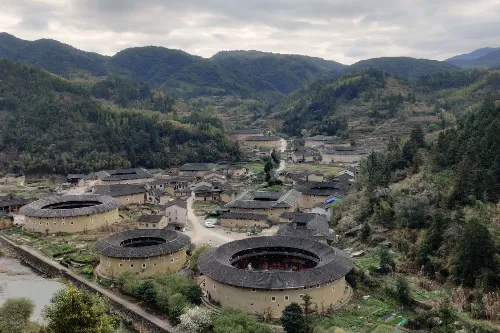
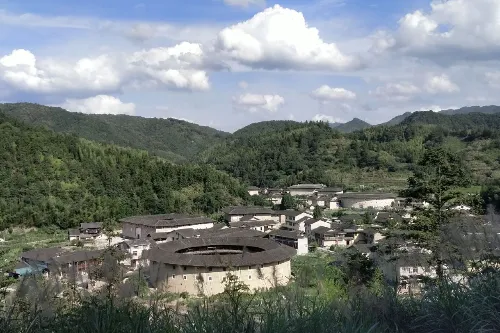
Travel Routes
Two-day Travel Route:
Day 1: Tianluokeng Area - Visit the Tianluokeng Tulou Cluster in the morning to admire the "Four Dishes and One Soup" landscape and learn about its history and culture; go to Yuchanglou in the afternoon to experience the magic of its "tilted pillars", then stroll along the stream in Taxia Village to appreciate ancient dwellings and the stone dragon flagpoles of Deyuantang.
Day 2: Yunshuiyao Area - Tour Yunshuiyao Ancient Town in the morning, walk along the ancient plank road to see thousand-year-old banyan trees, a century-old street and tulou buildings; visit Heguilou and Huaiyuanlou in the afternoon to learn about their architectural features and the stories behind them. If time permits, you can go to the Hekeng Tulou Cluster to see the "Big Dipper" tulou group.
Travel Suggestions
- The scenic area is large; plan your travel route in advance and arrange your time reasonably to avoid a hasty visit.
- There are many pebble roads in the scenic area; it is recommended to wear comfortable sports shoes or casual shoes and pay attention to safety while walking.
- There are many mosquitoes and insects; carry mosquito repellent to prevent bites.
- Climbing some tulou buildings requires an additional fee (about 10 yuan); you can choose according to your interest.
- When tasting local food, choose restaurants frequented by locals for authentic flavors and affordable prices.
Notes
- Tulou buildings are scattered in the mountainous areas of southern Fujian; the main means of transportation are private cars, minivans and motorcycle taxis, which are relatively expensive. You can share a chartered car with others to save costs and time.
- Check the weather forecast before traveling and prepare rain gear; take sun protection measures in summer, including sun-protective clothing, a sun hat, sunglasses and sunscreen.
- Respect local customs and cultural traditions; do not make loud noises or behave uncivilly inside the tulou buildings.
- When visiting tulou buildings, do not touch or damage cultural relics and historic sites at will, and keep the tulou buildings clean and tidy.
Transportation
- External Transportation: First arrive in Nanjing County, then reach the scenic area via the Nanjing County Special Tourism Highway (Shanmei Highway); or take the high-speed rail to Nanjing Station, then take a tourist special line bus, regular bus or taxi to the scenic area after getting off the train.
- Internal Transportation: Transportation in the scenic area is mainly by car and on foot, with roads including cement pavements, pebble pavements, and a small number of gravel roads and dirt roads. There are shuttle buses between various attractions for the convenience of tourists.
Opening Hours
Open daily from 08:30 to 17:00 all year round.
Tickets
Ticket price: 90 yuan per person.
You can search for the official WeChat public account "福建土楼南靖景区" to get the latest updates or purchase tickets online.
Online Booking
Click here to jump to the Trip.com ticketing platform for ticket purchase.


